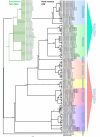Extremely distinct microbial communities in closely related leafhopper subfamilies: Typhlocybinae and Eurymelinae (Cicadellidae, Hemiptera)
- PMID: 40569073
- PMCID: PMC12282065
- DOI: 10.1128/msystems.00603-25
Extremely distinct microbial communities in closely related leafhopper subfamilies: Typhlocybinae and Eurymelinae (Cicadellidae, Hemiptera)
Abstract
Among the Hemiptera insects, a widespread way of feeding is sucking sap from host plants. Due to their nutrient-poor diet, these insects enter into obligate symbiosis with their microorganisms involved in the synthesis of components essential for host survival. However, within the Cicadellidae family, there is a relatively large group of mesophyll feeders-Typhlocybinae-that is considered to be devoid of obligate symbiotic companions. In this work, we examine the composition of microorganisms in this subfamily and compare the results with their close relatives-the Eurymelinae subfamily. To study the microbiome, we used high-throughput next-generation sequencing (NGS, Illumina) and advanced microscopic techniques, such as transmission electron microscopy (TEM) and fluorescence in situ hybridization (FISH), in a confocal microscope. In the bodies of Typhlocybinae insects, we did not detect the presence of microorganisms deemed to be obligate symbionts. Their microbial communities consist of facultative symbionts, mainly alphaproteobacteria such as Wolbachia or Rickettsia as well as others that can be considered as facultative, including Spiroplasma, Acidocella, Arsenophonus, Sodalis, Lariskella, Serratia, Cardinium, and Asaia. On the other hand, the Eurymelinae group is characterized by a high diversity of microbial communities, both obligate and facultative, similar to other Cicadomorpha. We find co-symbionts involved in the synthesis of essential amino acids such as Karelsulcia, betaproteobacteria Nasuia, or gammaproteobacteria Sodalis. In other representatives, we observed symbiotic yeast-like fungi from the family Ophiocordycipitaceae or Arsenophonus bacteria inhabiting the interior of Karelsulcia bacteria. Additionally, we investigated some aspects of symbiont transmission and the phylogeny of symbiotic organisms and their hosts.
Importance: The Typhlocybinae and Eurymelinae leafhoppers differ significantly in their symbiotic communities. They have different diets, as Typhlocybinae insects feed on parenchyma, which is richer in nutrients, while Eurymelinae, like most representatives of Auchenorrhyncha, consume sap from the phloem fibers of plants. Our work presents comprehensive studies of 42 species belonging to the two above-mentioned, and so far poorly known, Cicadomorpha subfamilies. Phylogenetic studies indicate that the insects from the studied groups have a common ancestor. The diet shift in the Typhlocybinae leafhoppers contributed to major changes in the composition of microorganisms inhabiting the body of these insects. Research on the impact of diet on the microbiome and the subsequent consequences on the evolution and adaptation of organisms plays an important role in the era of climate change.
Keywords: endosymbionts; insect microbiome; leafhoppers; microbial ecology; symbiotic bacteria; symbiotic fungi.
Conflict of interest statement
The authors declare no conflict of interest.
Figures






Similar articles
-
An obligate symbiont of Haematomyzus elephantis with a strongly reduced genome resembles symbiotic bacteria in sucking lice.Appl Environ Microbiol. 2025 Jun 18;91(6):e0022025. doi: 10.1128/aem.00220-25. Epub 2025 May 14. Appl Environ Microbiol. 2025. PMID: 40366182 Free PMC article.
-
From insect endosymbiont to phloem colonizer: comparative genomics unveils the lifestyle transition of phytopathogenic Arsenophonus strains.mSystems. 2025 May 20;10(5):e0149624. doi: 10.1128/msystems.01496-24. Epub 2025 Apr 9. mSystems. 2025. PMID: 40202301 Free PMC article.
-
Signs and symptoms to determine if a patient presenting in primary care or hospital outpatient settings has COVID-19.Cochrane Database Syst Rev. 2022 May 20;5(5):CD013665. doi: 10.1002/14651858.CD013665.pub3. Cochrane Database Syst Rev. 2022. PMID: 35593186 Free PMC article.
-
Sexual Harassment and Prevention Training.2024 Mar 29. In: StatPearls [Internet]. Treasure Island (FL): StatPearls Publishing; 2025 Jan–. 2024 Mar 29. In: StatPearls [Internet]. Treasure Island (FL): StatPearls Publishing; 2025 Jan–. PMID: 36508513 Free Books & Documents.
-
The Black Book of Psychotropic Dosing and Monitoring.Psychopharmacol Bull. 2024 Jul 8;54(3):8-59. Psychopharmacol Bull. 2024. PMID: 38993656 Free PMC article. Review.
References
-
- Cryan JR, Urban JM. 2012. Higher-level phylogeny of the insect order Hemiptera: is Auchenorrhyncha really paraphyletic? Syst Entomol 37:7–21. doi: 10.1111/j.1365-3113.2011.00611.x - DOI
-
- Dietrich CH, Allen JM, Lemmon AR, Lemmon EM, Takiya DM, Evangelista O, Walden KKO, Grady PGS, Johnson KP. 2017. Anchored hybrid enrichment-based Phylogenomics of leafhoppers and treehoppers (Hemiptera: Cicadomorpha: Membracoidea). Insect Syst Divers 1:57–72. doi: 10.1093/isd/ixx003 - DOI
-
- Zahniser JN, Dietrich CH. 2010. Phylogeny of the leafhopper subfamily Deltocephalinae (Hemiptera: Cicadellidae) based on molecular and morphological data with a revised family-group classification. Syst Entomol 35:489–511. doi: 10.1111/j.1365-3113.2010.00522.x - DOI
-
- Dietrich CH. 2013. South American leafhoppers of the tribe Typhlocybini (Hemiptera: Cicadellidae: Typhlocybinae). Zoologia (Curitiba) 30:519–568. doi: 10.1590/S1984-46702013000500008 - DOI
-
- Cao Y, Dietrich CH, Kits JH, Dmitriev DA, Richter R, Eyres J, Dettman JR, Xu Y, Huang M. 2023. Phylogenomics of microleafhoppers (Hemiptera: Cicadellidae: Typhlocybinae): morphological evolution, divergence times, and biogeography. Insect Syst Divers 7. doi: 10.1093/isd/ixad010 - DOI
MeSH terms
Grants and funding
LinkOut - more resources
Full Text Sources
Miscellaneous

